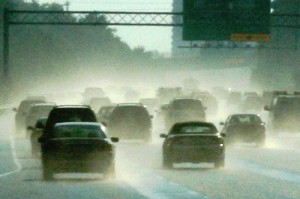
Photo credit: woodleywonderworks on Flickr
Recently I was sitting inside – writing about safety – and I kept hearing mega-splashes on the road. I realized, from the sound, that the leaves had clogged the drain on the road, which could lead to hydroplaning.
Instead of sitting inside, writing about safety, I decided to go outside and deal with the problem. So I grabbed an old broom, walked to the intersection, pressed the pedestrian button, and stood back about three metres to avoid getting showered by puddle water from passing cars.
When the cars came to a stop at the pedestrian light, I looked around carefully, went to the edge of the road, and stabbed the end of the broom into the slimey blob of leaves blocking the drain grate. The mini-lake drained instantly, bubbling and swirling down into the sewer. I went inside and got back to work – feeling most satisfied about my little safety fix.
But there are many other big patches of water on the road and it’s important to “Drop your speed to match road conditions,” according to this tip on the Shift Into Winter website.
Add leaves to the mix and it’s even worse – especially when they clog the drains and big puddles form, putting cars at risk of hydroplaning, which can cause drivers to lose control.
“Hydroplaning occurs when a thin layer of water causes your tires to lose contact with the road,” reads this Road Safety announcement from the City of Port Coquitlam, advising drivers to do the following if their vehicles hydroplane:
- Keep both hands on the steering wheel, steering gently in the direction you want your car to go
- Slow down, and do not slam on the brakes
- Ensure your tires are properly inflated, have good tread, and are “all weather” tires designed for bad road conditions
Check out Road Safety at Work if you drive as part of your job, and check out this video on what to if you hydroplane.


